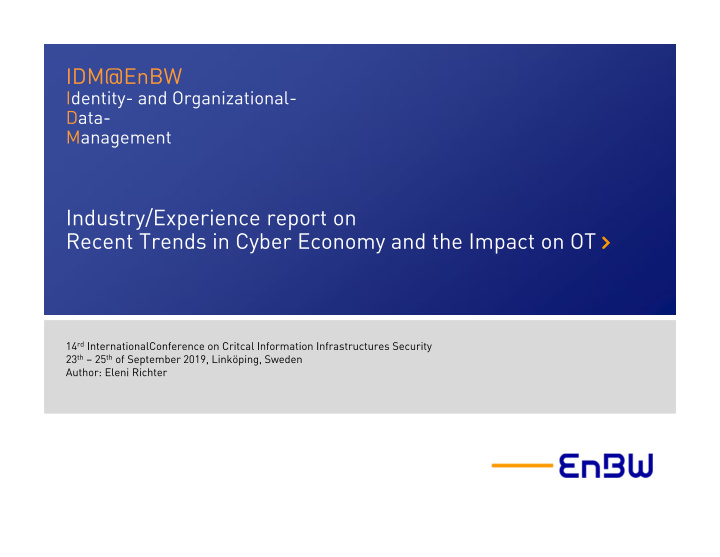



Preface About speaker and content Industry/Experience report on Recent Trends in Cyber Economy and the Impact on OT Who am I? Name: Eleni Richter Education: Wirtschaftsingenieur (University of Karlsruhe TH) Sketch- Book More than 18 years in different positions at EnBW: IT-security-manager, IT-consultant, IT- system designer, project-manager and architect Engineer What am I doing right now? IDM = Identity and Organizational Data Management * Collection of various data in the company Contains eight sketches, * Processing, aggregation, transformation, interlinking data models and examples on * Giving the data to Office IT and Operational IT for usage recent trends in IT and OT in on premise and in cloud scenarios 2
SKETCH № 1 Typical functioning of an Energy Supplier Energy Supplying Energy Production Sales Energy Energy Trading Transport * Number three in German Energy Market. * Five main business parts: widely different characteristics Critical infrastructure Trading regulation ... need to work together Grid, more decentralized Distributed character, close to customer Depending on data and IT 3
SKETCH № 2 The changing face of an Energy Supplier Energy Supplying Energy Production Sales Energy Energy Energy Trading Transport Native cloud companies, Transport start-ups, web companies Many fundamental changes * Liberalization of the energy market => unbundling * End of nuclear power usage => renewable energies => decentralization * Energy production on consumer side => more distributed micro-scenarios * Low market prices for enery => need for new business opportunities => aggressive competitors 4
SKETCH № 3 Some Impacts of Digital Transformation at EnBW Data How-to-cloud (short version) Need for data and interaction source usage a. Rent or build a cloud-service b. Configure or implement the solution Energy c. Manage customers, partners... Supplying => identities and relations Energy Production How-to-IoT (very short version) Sales + Energy Energy Trading a. Get interoperable IT-gadgets Transport b. Implement the solution, adapt OT c. Manage identities and relations New business opportunity New business opportunity OT = operational technology involving some cloud-service involving some IoT, OT IoT = internet of things services or other smart 5 technologies
SKETCH № 4 Compliance for cloud applications For each cloud service you have to… Organize usage and administration Check IT-security xxxx xxxxxxxx Check OT xxxxxxxx xxxxxxxx Check contract with cloud New business provider, online terms, … opportunity involving some cloud- or Check IoT-service information- security Review data protection * New GDPR * Privacy by design, by default Check with => Breach will be expensive works council Check other compliance * Sector specific compliance * … 6
SKETCH № 5 Is there any relevance for OT? (c) Tomorrow Data source usage (a) Yesterday Automatically check OT “A lot of calculation Big Data Locally check & power is needed so we Analytics maintenance rent it in the cloud” Operational IT and office IT clearly separated. Automatically “Mobile staff should use manage smart gadgets via (b) Today maintenance internet so we rent a cloud-service” Remote call for maintenance IT Maintenance and change IT/OT-data Remote check & maintenance, some additional office IT Office IT technologies get partly mixed into operational IT. 7
SKETCH № 6 Some thoughts on future prospects and widely divergent aims Pulling and pushing factors production on demand, agility, flexibility industry 4.0 Operational Office Cloud IT internet of IT IT things (IoT) remote * internet, cloud * LAN, internet * isolation maintenance * even more * multi-purpose * specialized reduce cost standard standard hardware hardware reduce cost and software * fitted quality and and software features * good quality and features Over all standardized technology allows * interfaces, exchange * cooperation, mixed areas * integrated areas 8
SKETCH № 7 Comparison of on-premise and cloud-systems: a risk based approach Top five differences (1) Location * in-place, private * far away, through public space * less distribution possible * more distributed (2) Changes * fully under your control * cloud-provider driven (3) Environment* reliability up to you * not completely reliable ex definition (internet) (4) More possibilities to do things wrong Risk = Damagex Probability favourable cases Probability = whole number of cases possible (5) More publicity if you do things wrong 9
SKETCH № 8 Finding a suitable risk-model for your cloud-business (1) Determine system boundary (2) Interaction Application: Technical and organizational determined system Application local effect stay local limited effect cooperation with partner general effect general rules apply (3) Responsibilty (4) Rules for important general domains Accounting Metering * Knows his system Data Data and the boundary * Knows interaction Some criteria for * Organizes jobs and importance: Responsible tasks * compliance Manager * expensive IDM * critical process Organize some governance for really important domains which have general effects 10
Final Word Summary Industry/Experience report on Recent Trends in Cyber Economy and the Impact on OT * Cloud-services are important enablers for your business. We consider this to be unstoppable and irreversible. We need to arrange us in a multi-cloud situation. * The internet environment is quite unsuitable for OT: unpredictable changes, distributed, including failure, errors and security issues as frauds and attacks. * A lot of measurement and engineering is necessary to run a stable and secure business. * A risk based model is the right way to identify the important parts. A possible result of a risk analysis could be that you don’t want to run something as a cloud service any more. 11
Recommend
More recommend